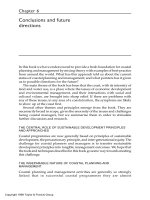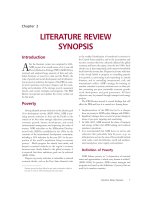Corporate Environmental Management - Chapter 2 pps
Bạn đang xem bản rút gọn của tài liệu. Xem và tải ngay bản đầy đủ của tài liệu tại đây (370.24 KB, 3 trang )
9
Chapter 2
Environmental
Management
Assessment
Given the uniqueness of environmental management issues and its position
outside the mainstream of the company’s day-to-day operating activities, it
can be difficult for corporate management to assess the state of its program.
One way to garner such independent assessment is to engage an environ-
mental management assessment. An
environmental management assessment
provides a unique perspective that encompasses a senior management
viewpoint along with a critical, technically astute, regulatory agency per-
spective. As such, the environmental management assessment can provide
a critical assessment of the integrated fit of a company’s environmental man-
agement program, an independent measurement of its effectiveness, and the
timely identification of any potentially serious deficiency, as well as specific
recommendations for programmatic improvements.
The central question that must be asked is, “What will be the role of the
environmental health and safety (EHS) function?“ Is the EHS function a mere
commodity to achieve efficient compliance or is it a growth function based
on a resurgence of societal pressures and regulation? Taking the latter point
a step further, it can be argued that EHS has become a critical element of a
successful 21st-century business strategy. Furthermore, as depicted in
Exhibit 3 there are potential business consequences for the “efficient com-
pliance” approach.
It is our view that the “best practice” EHS operating model is the
“business partnership” model. This model calls for creating a strong EHS
component in strategic planning and investigating beyond required compli-
ance. In short, the company incorporates a design for environment philos-
ophy into product development and process design. Under this approach,
EHS issues are recognized as meaningful components of overall value
propositions. There is also a concerted effort to not only measure EHS
returns over time but to understand that, as noted in Exhibit 4, a severe lack
of aggressive EHS compliance can result in even greater long-term costs.
55461_C002.fm Page 9 Friday, March 30, 2007 7:28 AM
© 2008 by Taylor & Francis Group, LLC
10
CORPORATE ENVIRONMENTAL MANAGEMENT
The environmental management assessment analysis should employ
tested methodologies for extracting key issues that may be adversely influ-
encing the company’s environmental management program. As discussed
in the text and shown in Exhibit 4, the company’s environmental manage-
ment program can be strongly influenced by the degree to which the effort
is integrated. It is our hope that the environmental management assessment
analysis will enhance both the understanding and the implementation of
such integration.
To be successful, the environmental management assessment should be
an upper management exercise, preferably a board of directors-generated
exercise. While significant day-to-day coordination and cooperation will be
needed at both the operating and environmental management levels, it is
essential that results be transmitted directly and freely to the highest
corporate levels to ensure independence.
Exhibit 3. Business consequences of the “efficient compliance” approach.
Exhibit 4. Few environmental restoration chains are effectively integrated.
Lower Share Valuation
Efficient
Compliance
Growth Constraints
Missed Product
Innovation Opportunities
Costly Retrofits & Penalties
Missed Production
Innovation Opportunities
Potential Public Image
Damage
Missed Renewable
Energy Opportunities
High
investigation
costs?
Will
technologies
be delivered?
Supplier’s
suppliers
(vendors)
Customer’s
customers
(public)
Suppliers
(A/Es)
Company
Customers
(EPA)
Design
Acquire
Process
Remediate
Negotiate
Will deadlines
be met?
Waste disposal
requirements/
restrictions?
NRD claims?
Cleanup levels?
Fast track
rods?
55461_C002.fm Page 10 Friday, March 30, 2007 7:28 AM
© 2008 by Taylor & Francis Group, LLC
11
Environmental Management Assessment
Recognize that CEOs and board members face significant responsibili-
ties and liabilities with regard to environmental management performance.
An independent environmental management assessment provides both a
practical method for minimizing exposure to liabilities as well as a sound
legal defense for making appropriate efforts to ensure successful environ-
mental management performance and the assessment of exposures.
Also recognize that at first glance, some uncertainties may lie outside
the control of environmental management. These uncertainties relate to
unresolved issues, undeclared agendas, or responses by parties to the
environmental management process. Effective environmental management
seeks to identify, early-envelope, and convert these uncertainties into
known factors that can be included in the overall management plan.
Besides dealing with uncertainty, the objective of the environmental
management process should also be to increase the overall effectiveness
by which organizational resources committed to environmental programs
are used. In essence, environmental management programs must effec-
tively integrate regulatory, technical, and management issues to provide
well-rounded, cost-effective environmental management solutions.
The focus of the environmental management organization should not
be limited to overall environmental management goal setting (i.e., the
“bully pulpit” or sermonizing) but should include detailed technical
planning responsibilities, regulatory documentation preparation, and
establishing environmental cost estimation and training protocols to
ensure the desired results are achieved. The process should also encom-
pass the detailed preparation of critical environmental regulatory
documents and corporate positions as well as technical support informa-
tion that provides a strategic value to the company and the company’s
cost, financial, schedule, and regulatory objectives. Select activities
should not be treated as individual events but as part of the total view to
the environmental management problem identification and resolution
process. As a result, the process generates a greater understanding of
potential resource requirements and the impact of technical and regula-
tory hurdles to meeting environmental management goals.
Proactive Corporate Environmental Management must recognize that
environmental risk is more than the assessment of individual company
risks due to accidents, major incidents, unexpected regulatory cost
impacts, or unexpected damage to brand reputation. True environmental
risks are the bottom-line impacts on the stock of the company. To that end,
the objective is to provide the investment community with environmental
information that accurately reflects the company’s environmental manage-
ment performance and that can be translated in hard financial terms.
55461_C002.fm Page 11 Friday, March 30, 2007 7:28 AM
© 2008 by Taylor & Francis Group, LLC









